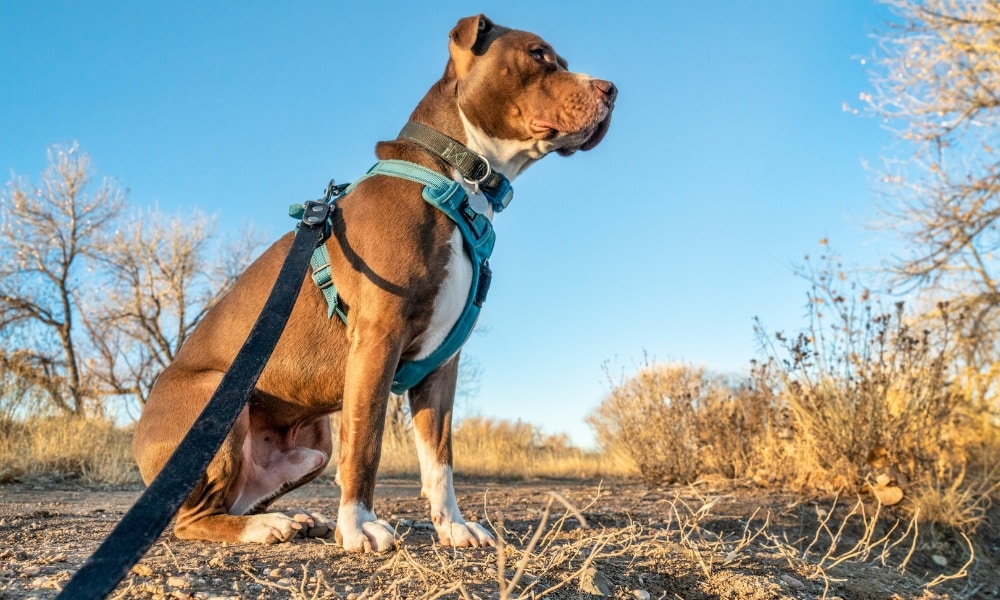Harnesses have been used in dog training for many years. The equipment gives you more control over a large dog, especially during hiking or in a shopping mall.
Also, if your furry friend has respiratory issues, a harness will serve better than a collar.
A harness that does not fit properly can cause injuries or discomfort to a dog. This article will share some advantages and disadvantages of using a dog harness for large dogs. Keep reading.
Why do Dog Owners Use Harnesses?
When you use a leash on a dog, you exert pressure on its body. With a collar, the pressure stays concentrated on the dog’s neck and may cause its eyes to pop, among other discomforts.
However, when you use a harness, the leash’s pressure on the dog becomes evenly distributed to the chest.
Before now, dog owners only used harnesses for their puppies. However, individuals who own larger dogs have embraced the practice. Whatever the case, ensure the harness properly fits the dog, whether a large dog or a smaller puppy.
Ideally, a harness should not obstruct any natural movement of your dog. The main areas of concern are the region around the front legs’ extension and the shoulders.
Luckily, there are different sizes of harnesses for any dog. A common practice we recommend is taking your four-legged friend when you get a harness for him. That way, you can fit the equipment to be sure it fits before paying.
Advantages of using a dog harness for large dogs
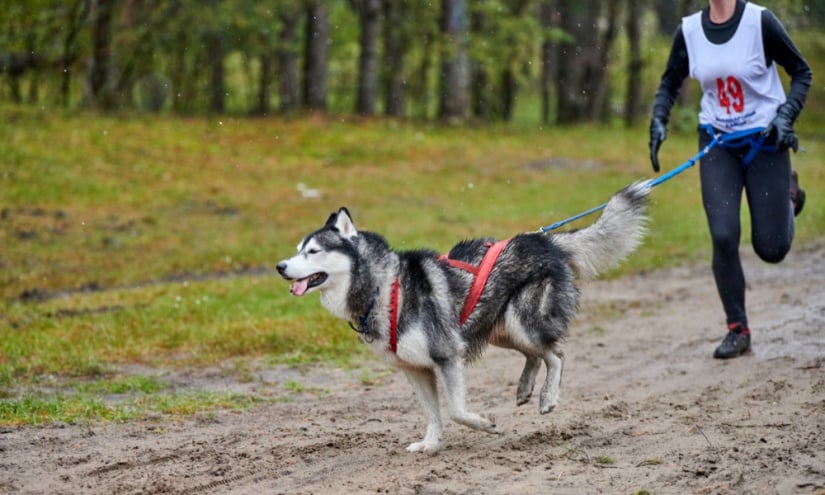
Here are the major advantages of using a dog harness for large dogs.
Increased control over your dog
Harnesses give additional control over your dog more than any other equipment used for the purpose.
You need adequate control over your dog, especially when entering crowded places. The ability to control your large friend is important if it has this habit of jumping on people playfully.
A harness helps to evenly spread the pressure and tension from the leash across other parts of the dog’s body instead of concentrating it on the neck.
It spreads across the dog’s shoulders, upper back, and chest. This is particularly effective if your dog is large enough to pull you along when using a collar.
It Prevents Your Dog From Pulling
The harness wraps around your dog’s chest and behind the front legs. For dogs that pull out their collars, harnesses keep them in check. It sits on the chest, which happens to be the center of gravity.
So, when they try to pull against the harness, it only makes them move forward. This harness mechanism keeps the dog turned towards you and prevents it from pulling free.
Harnesses Help to Prevent Injuries
Compared to collars, harnesses are best for your dog when guiding them with a leash. Certain dog breeds, like the Labrador Retriever and English Bulldog, are very fragile and may sustain injuries from excessive pressure around the neck.
Harnesses distribute the pressure and tension from the leash to other body parts like the chest. They also help to enhance your safety, as your large dog won’t strain your arm when they pull.
In addition, your excited dog won’t tangle itself or you if they have a harness on.
It Keeps the Dog from Escaping
An escapee dog without a tag could easily pass for a stray dog. There are high chances of your dog wriggling out of a collar but not when controlling them with a harness.
This is especially possible if you own a thin-faced breed like the greyhound. A Greyhound can easily slip out of a collar and run off. But with a harness, the chances of this are almost zero.
It Provides multiple attachment points
With a harness, you have multiple options for leash attachment. While most harnesses have specified leash attachments, some offer multiple attachment options.
If you’re concerned about the dog pulling at the leash, you can opt for the front-clip leash. This type of harness allows you to attach the leash to the neck of the dog.
There’s also the back-clip harness which allows you to clip the leash on the neck. This is a big plus for large dogs where a neck restraint can be a problem.
Despite the many advantages, using the equipment has some disadvantages, too, especially for larger dogs. But before you use a harness on your large pet, get a suitable dog harness for your dog.
Disadvantages of using a dog harness for large dogs
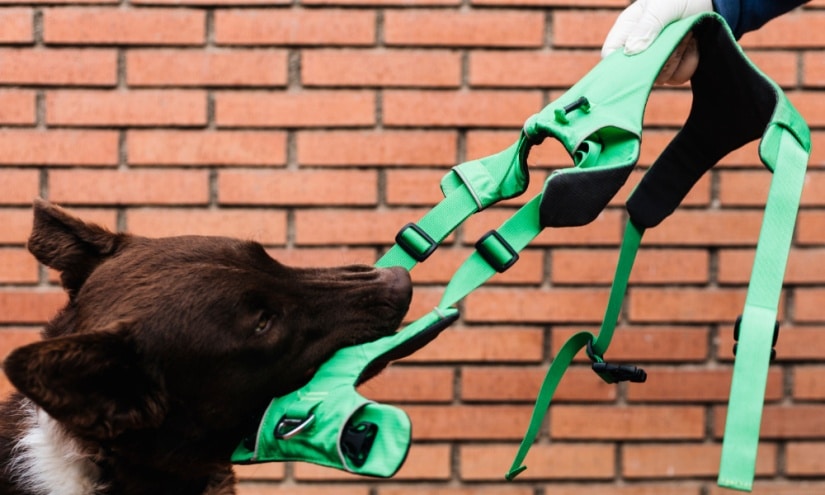
Here are the disadvantages of using a dog harness for large dogs.
Potential cause of injuries
If your dog wears a harness that doesn’t fit, it faces a high risk of chest injuries. The risk is even higher if the dog pulls hard to escape the leash.
If you’re using a type of harness known as the head halter, this could be risky for dogs that easily get excited.
If a dog wearing a head halter runs forward and is suddenly jerked backward by the owner, a neck injury may result. In addition, many dogs find it difficult to adapt to this equipment.
So, they always struggle at the beginning to vent their frustration. If your dog is a hairy breed, it stands a greater risk of sustaining injuries.
It Could be Risky if Worn While Asleep
If a dog falls asleep while wearing a harness, it might get caught by something. Sometimes, this may cause a choking hazard. Also, a dog wearing a harness for prolonged hours could irritate the skin.
Finding the Right Fit Could be Tasking
There are many different types and sizes of harnesses. Most times, rummaging through to find the right fit for your dog can be daunting.
If you mistakenly pick the wrong fit, you risk making your dear animal friend suffer injuries.
Your Large Dog May Have a Hard Time Adapting
If you didn’t train your large dog to wear harnesses, you’d find it difficult to make it wear the equipment later. Also, your dog may find it uncomfortable as it is heavier than a collar. So, it will take a long while for your large dog to adapt to its usage.
Also, using a harness is more tasking than using a collar. You can easily slip a collar off or on. On the other hand, it will take longer to get the harness on your dog or take it off.
Factors to Consider When Choosing a Harness for your Large Dog
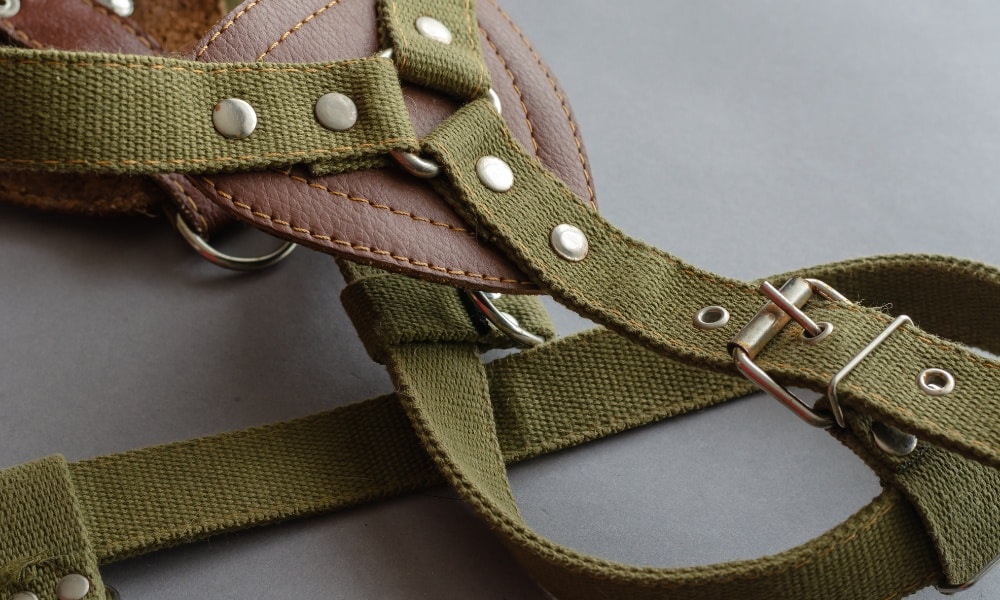
Before you choose a harness for your dog, you must consider certain factors to ensure your dog’s safety. But first, you should know the different types of dog harnesses as it will aid your decision too.
The available designs are the back-clip harness, dual-clip harness, front-clip harness, step-in harness, and head halter.
Below are certain factors you must consider when picking a harness for your large dog.
The Harness Must be Comfortable
When choosing a harness for your dog, comfort should be a paramount determinant of what you pick. We recommend cotton weave harnesses since they have a natural and soft feel. This is a better option than regular synthetic materials, which tend to be harder.
Pay Attention to the Design
Your large pet’s harness must not exert excessive pressure on any part of the dog’s body. We advise you only pick a harness with a design that doesn’t restrict movements around the shoulders.
In addition, the dog should be able to move, walk, and run without restraints.
It Must Fit Properly
Fitting goes a long way in determining how comfortable your furry friend will feel when they wear the harness. Take your dog to the shop when you buy the harness to avoid misfits.
The best harnesses should make room for any necessary adjustments. If you can take your dog’s measurements, you can order a custom-made harness.
When to Use a Harness
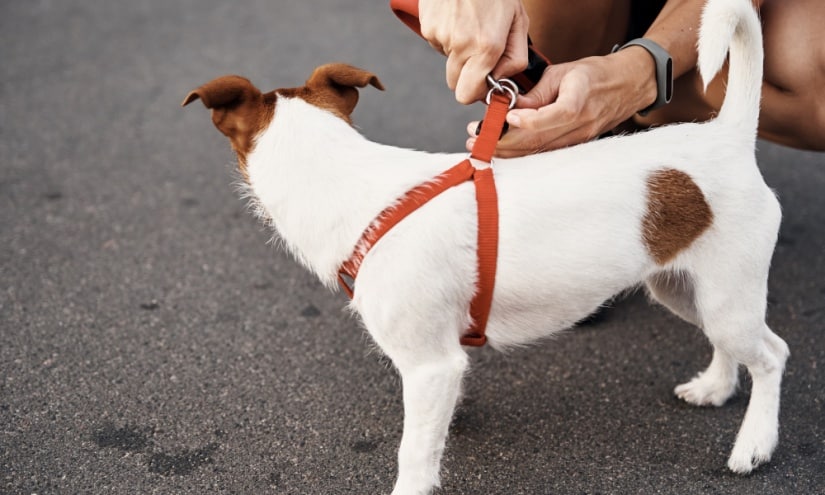
- Use a harness instead of a collar if your dog has respiratory issues (common with brachycephalic breeds). A common example of this breed is the French bulldog.
- Use a harness on dogs with a history of tracheal collapse. Tracheal collapse occurs when the dog’s trachea folds, resulting in difficulty breathing or coughing.
- Harnesses are effective in managing dog breeds that stand a risk of spinal conditions, like the Dachshund. It takes the pressure off the neck and spine, preventing further damage.
- Dogs with orthopedic issues can be better managed using a harness.
Conclusion
A harness is a cool piece of equipment that help you train your dog with more control. It is also more comfortable since it evenly dissipates the tension and pressure from the neck.
However, you should pay additional attention when using it with hairy dogs, as it could cause injuries. More importantly, ensure that the harness fits properly on your dog.
